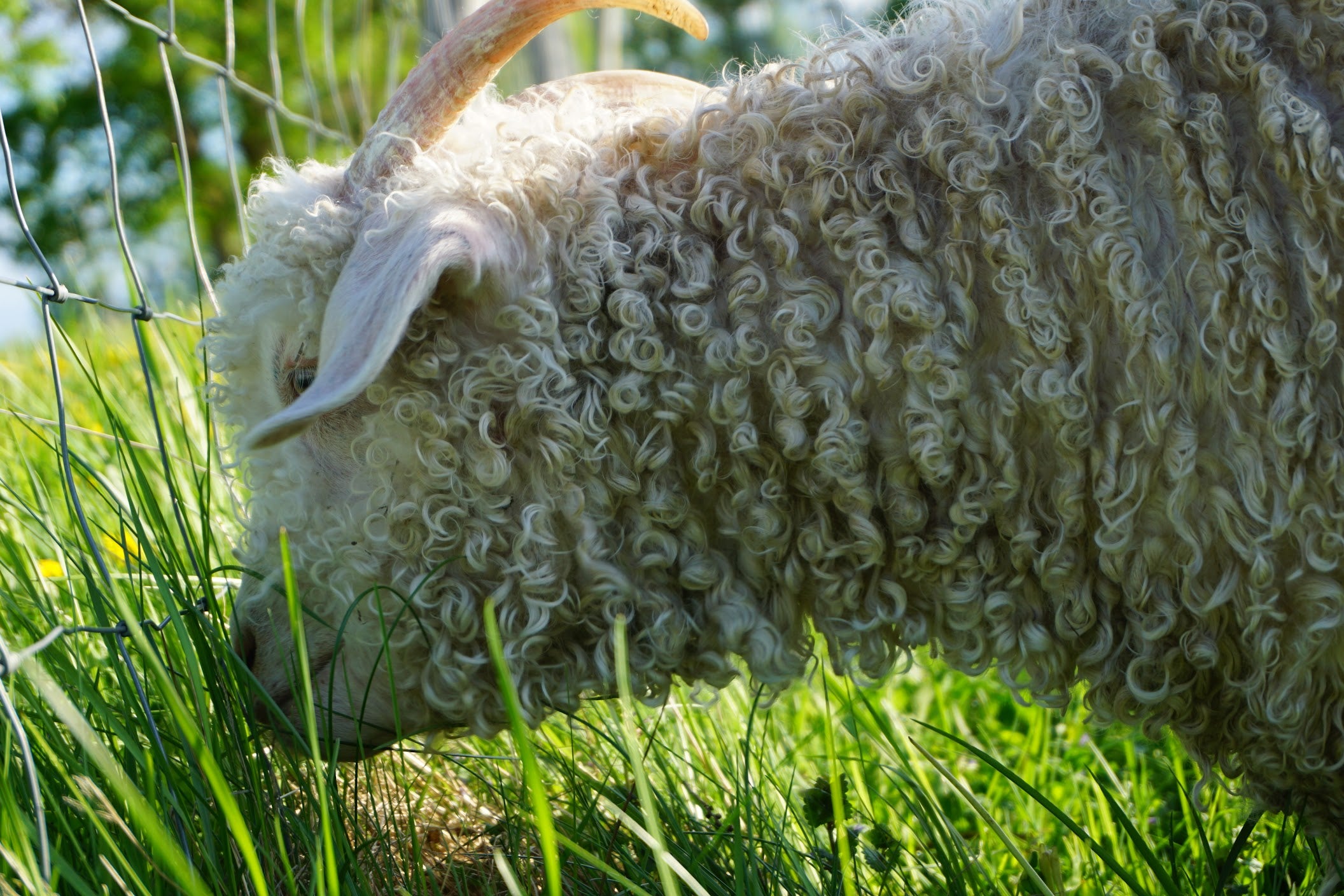
Mohair, the Diamond Fibre
Natural, authentic,luxurious with its unique lustre
Mohair (derived from the Arabic "Mukhayyar" which means "the one that is chosen, the most beautiful") is an exceptional fibre that comes exclusively from the Angora goat.
As you can read on our page dedicated to this goat, Angora goat is a very ancient breed whose immaculate fleeces were highly prized and intended for kings and sultans.
Physical Characteristics
The numerous qualities of Mohair are due to its unique physical appearance.
In fact, the mohair hair is made of long scales, lying one on top of the other which gives it a smooth and slippery appearance, softer to the touch and more lustrous (reflection of the light on the scales).
Moreover, its hollow centre gives it lightness, great thermal insulating power and strong resistance to wear.
Finally, as originally it is made of curls (name locks), it maintains its natural elasticity.
Mohair Qualities
-
Unique natural lustre which gives a silky sheen to garments and fashion accessories.

-
Long lasting, vivid intense colours: Mohair responds really well to dyes (thanks to the very singular arrangement of the large scales of its fibre) and resists fading by time or hard wear.

- Shrink resistance: Mohair felts much less than wool because of its smooth fibre characteristic
- Resistant to soiling: As a slippery fibre, dust doesn't come to rest, which is ideal for woven fabrics. Dirt remaining on such materials can be easily removed with a shake or brushing.

- Durability and strength: Because of its high tensile strength due to its structure, Mohair can be twisted and bent without damage to the fibre. Thereby, products made from Mohair last longer and are extremely durable
-
Thermoregulating: Mohair breathes naturally, whereas human-made threads cannot. Thanks to its excellent insulating properties it protects from the cold in winter, while its moisture-wicking properties allow it to remain cool in summer and moving perspiration away from the skin.

- High Elasticity: Mohair can stretch up to 30% of its length then spring back into shape. This elasticity helps mohair garments hold their shape and resist wrinkling, stretching or sagging during wear
-
Lightweight and great softness: it make Mohair garments very comfortable to wear next to the skin

- Because of its texture, similar to human hair, Mohair is also used for making high quality doll wigs (like newborn babies) and Santa Claus beards
- Non-flammable: When placed near a naked flame, it tends to shrivel into a kind of ash and stops burning instantaneously once taken away.

- Texture: Mohair can be blended with other fibres to add a touch of texture, vibrant colours, lustre, sheen, volume, strength and elasticity
Mohair is good for the environment
- Natural renewable resource ( shearing done twice a year)
- Limited impact on the environment because it requires less energy to be manufactured than all human-made threads with their chemical compounds
- 100% biodegradable: when not in use, it can be composted to fertilize soil.
Mohair Harvesting

The long curls (locks) that form the fleece of these goats grow 2.5 cm (1 in.) per month. This is the reason why Angora goats are shorn twice a year. The fleeces weigh between 1 kg and 3.5 kg (2 lbs to 6lbs ) per shearing (depending on the age of the goat) and are carefully sorted and classified into different categories.
Mohair Categories
- Kid mohair ( baby goat): The fleeces of the babies are the finest (between 23 and 28 microns), softest, lightest, brightest of all. It is the most prized and expensive category because of its rareness: these are the fleeces of the first two shearings (6 months and 1 year old). This soft, light and fine mohair is perfect for any garments worn directly on the skin.

- Yearling (teenager): These are beautiful, abundant fleeces with long and regular locks. This mohair is very similar to the kid mohair while being a little bit coarser (between 26 and 30 microns). In general, this category includes fleeces from the 3rd and 4th shearings, but depending on the quality of the mohair, older animals can produce some yearling. It is an excellent choice for luxurious and durable clothing such as shawls, throws, cardigans or even woven suits.

- Young adult: Beautiful, abundant fleeces. They are similar to the yearlings' ones but loosing some finess (between 30 and 34 microns). These are generally the fleeces of animals aged 3 to 5 years. This mohair is ideal for durable and wear-resistant clothing such as socks, mittens, hats, blankets and outdoor jackets.

- Adult: Equal or less abundant fleeces, rougher, coarser (34 microns and more). These are the fleeces of older animals (6 years and over) and can be used in carpets, upholstery, insoles or for any other use where you will need a strong and durable thread.

Worldwide
The main Mohair producing countries are: South Africa (more than 50% of world production), the United States (mainly in Texas), Turkey. The city of Port Elisabeth (South Africa) is called the world capital of mohair because of the large volume of raw mohair transiting through its port and its worldwide auctions.
In the early 1990s, world production of mohair was estimated at 25,000 tonnes (55 millions pounds). Twenty years later, the volume produced on the globe is 5 times less.
The main importing-processing countries of raw mohair are Italy, China, the United Kingdom,...
For the first time in 2018, global production of cashmere (12 million pounds - 5,500 tons) exceeded production of kid mohair (1 million pounds - 455 tons).
Mohair is a very rare and precious resource
